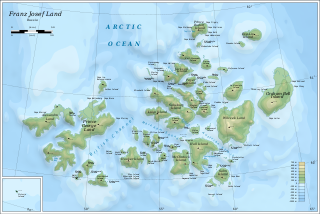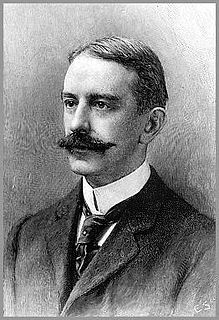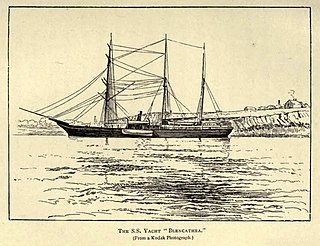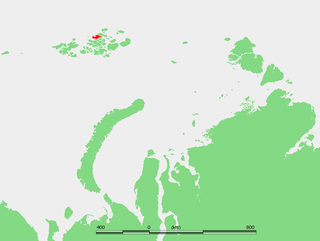Coordinates: 80°35′58″N44°54′45″E / 80.59944°N 44.91250°E

A geographic coordinate system is a coordinate system that enables every location on Earth to be specified by a set of numbers, letters or symbols. The coordinates are often chosen such that one of the numbers represents a vertical position and two or three of the numbers represent a horizontal position; alternatively, a geographic position may be expressed in a combined three-dimensional Cartesian vector. A common choice of coordinates is latitude, longitude and elevation. To specify a location on a plane requires a map projection.

Cape Mary Harmsworth (Russian: Мыс Мэри-Хармсуорт; Mys Meri Kharmsuort) is a cape located in Alexandra Land (Russian Federation).

Alexandra Land is a large island located in Franz Josef Land, Arkhangelsk Oblast, Russian Federation. Not counting detached and far-lying Victoria Island, it is the westernmost island of the Franz Josef Archipelago. It is the site of a Russian military base that was reopened in 2017.
This cape is the westernmost point of the Franz Josef Archipelago proper, not counting far-lying Victoria Island which is geographically detached from the group.

Franz Josef Land, Franz Joseph Land or Francis Joseph's Land is a Russian archipelago, inhabited only by military personnel, located in the Arctic Ocean and constituting the northernmost part of Arkhangelsk Oblast. It consists of 191 islands, which cover an area of 16,134 square kilometers (6,229 sq mi), stretching 375 kilometers (233 mi) from east to west and 234 kilometers (145 mi) from north to south. The islands are categorized in three groups, a western, central and eastern, separated by the British Channel and the Austrian Strait. The central group is further divided into a northern and southern section by the Markham Strait. The largest island is Prince George Land, which measures 2,741 square kilometers (1,058 sq mi), followed by Wilczek Land, Graham Bell Island and Alexandra Land.
Cape Mary Harmsworth was named after Alfred Harmsworth' s wife Mary. Alfred Harmsworth, fellow of the Royal Geographical Society, was the main sponsor of the 1894 Jackson-Harmsworth Polar Expedition to Franz Joseph Land.

The Royal Geographical Society is the UK's learned society and professional body for geography, founded in 1830 for the advancement of geographical sciences. Today, it is the leading centre for geographers and geographical learning. The Society has over 16,500 members and its work reaches millions of people each year through publications, research groups and lectures.

Frederick George Jackson was an English Arctic explorer remembered for his expedition to Franz Josef Land, when he located the missing Norwegian explorer Fridtjof Nansen.
This is the place that Russian navigator Valerian Albanov of the Svyataya Anna reached in 1914 after his long and tragic ordeal on the Polar ice.

Valerian Ivanovich Albanov was a Russian navigator, best known for being one of two survivors of the Brusilov Expedition of 1912, which killed 22.

The Philomel-class gunvesselHMS Newport was launched in England in 1867. Having become the first ship to pass through the Suez Canal, she was sold in 1881 and renamed Pandora II. She was purchased again in about 1890 and renamed Blencathra, taking part in expeditions to the north coast of Russia. She was bought in 1912 by Georgy Brusilov for use in his ill-fated 1912 Arctic expedition to explore the Northern Sea Route, and was named Svyataya Anna, after Saint Anne. The ship became firmly trapped in ice; only two members of the expedition, Valerian Albanov and Alexander Konrad, survived. The ship has never been found.












